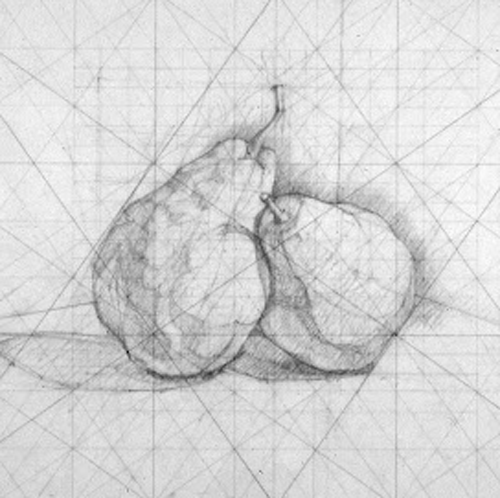The Barnstone Method Intensive: Foundation in Drawing & Design
$1,500.00 Original price was: $1,500.00.$1,000.00Current price is: $1,000.00.
About The Barnstone Method Intensive: Foundation in Drawing & Design
The Barnstone Method Intensive: Foundation in Drawing & Design
Instructor: Roger Brinker
All levels
Live class - via Zoom
Classes begin Wednesday, June 11, 2025*
*You will also receive a code to download all 10 lessons (at no additional cost) that are a part of Myron's lecture set: Foundation in Drawing & Design. This will allow you to get a head start on the class and work through all of the materials once before the live lecture begins in June, 2025. Myron's class recordings as well as the Roger's live class recordings will be yours to keep forever!
Summer 2025 Schedule:
Wednesday, June 11, 6:00 - 8:00 PM EST
Wednesday, June 18, 6:00 - 8:00 PM EST
Wednesday, June 25, 6:00 - 8:00 PM EST
Wednesday, July 2, 6:00 - 8:00 PM EST
Wednesday, July 9, 6:00 - 8:00 PM EST
Wednesday, July 16, 6:00 - 8:00 PM EST
Wednesday, July 23, 6:00 - 8:00 PM EST
Wednesday, July 30, 6:00 - 8:00 PM EST
Wednesday, August 6, 6:00 - 8:00 PM EST
Wednesday, August 13, 6:00 - 8:00 PM EST
What You'll Learn:
Your weekly Barnstone Method Intensive: Foundation in Drawing & Design course will begin with an introduction and orientation session, where Roger Brinker, master in the Barnstone Method and hand-selected by Myron Barnstone to carry forward Barnstone Method instruction, will introduce the full list of topic classes, the Barnstone Master Guide assistants with whom students will engage, course attendance and homework expectations and timelines.
Weekly Schedule
Each week’s educational session will be comprised of two hours live online lecture, plus approximately 90 minutes of pre-recorded lectures by Myron Barnstone himself, and one-to-one support from your personal Barnstone Master Guide.
Roger Brinker will begin each class by providing you with a recap of the previous week’s topics and assignments, as well as any points of interest that may have arisen from interim student questions and interactions with the Barnstone Master Guides.
You will receive a personalized introduction to each of Myron Barnstone’s recorded classes, giving a deeper context and calling attention to concepts of particular interest. Insights will be shared on how to apply these design concepts to your personal artwork and how to utilize the complexity of subjects that you will encounter in your individual designs.
You will receive a detailed description of the homework for the week, as well as answers to student’s questions.
Students will watch the full Barnstone lecture on their own and complete that week’s assignment before the following class meeting.
Barnstone Master Guides - seasoned professional alumnus that were trained by Myron Barnstone - will assist you individually. Giving one-to-one attention outside of the weekly meetings, they will address specific needs in student’s work, meeting students virtually to provide feedback to their questions.
On the next class date, work that has been uploaded to the Gallery will be reviewed by Roger Brinker to prepare students for the next lesson in the design sequence.
You will receive evergreen access to the full Barnstone Method Foundation Drawing & Design course including:
- Roger Brinker’s introduction to weekly lessons, student work critiques, and in-depth presentations on special topics.
- Myron Barnstone’s Foundation Drawing & Design series of recorded classes.
- Access to our growing video archive of special topics and techniques
The Barnstone Method Intensive: Foundation in Drawing & Design
Lesson 1: Introduction and Analysis of Bottle Design
Introduction to the basic principles and fundamental terms and ideas that are key to the Barnstone Method: observational measurement to assess proportions; construct a notional space; sight directions and coincidental relationships; apply triangulation; gesture drawing and analytical drawing procedures
Lesson 2: The Two Dimensional Bottle
Deconstruct complex forms into simple basic shapes; figure-to-ground relationships; rhythmic structures using linear parallels, radiating lines, enclosures, and arabesque; use of passage and vignette; aerial perspective; gazing direction; enclosures; vignette; negative spaces; gamut; how to identify visual errors
Lesson 3: The Sphere and the Cube
Conceive and describe the surface contours and cross-contours of a sphere; construct the circle template and divisions within the sphere; tessellation, cross-sections, and dimensional truncations; invent complex interior 3D geometries
Lesson 4: The Three Dimensional Bottle Projection
Build complex 3D forms from basic volumes; construct analytical 3D volumes for 2D shapes; create concentric ellipses of various diameters in a plane; compose volumetric objects in a pictorial field with an implied 3D space
Lesson 5: The Sphere in Value
Understand and apply highlight, light, shadow, shadow core, reflected light, cast shadow, light and dark halos; rendering techniques; relate the light direction to the 3D surface volume of a sphere; apply passage and vignette; emphasize versus flatten surface volumes using light and value
Lesson 6: The Bottles in Value
Apply directional lighting to the surfaces of 3D volumes; differentiate cast shadow and form shadow; apply aerial perspective, zoning, and pictorial emphasis; Rembrandt lighting; value rendering
Lesson 7: The Golden Section and Root Rectangles
Distinguish and construct Golden Section and root rectangle geometry; the armature of a rectangle, diagonals, crossing lines; the gamut; composition; deconstruct geometry into proportional armatures; establish spatial hierarchies; compose imagery into the geometry of a rectangle
Lesson 8: The Plant
Plan and compose a complex design subject; design visual pathways and gamut; arrange relative positions and overlaps; foreshortening; organize 3D arabesques; apply rhythmic structures to create coincidences and harmonize diverse parts of a design
Lesson 9: The Portrait - Geometry of the Head
Recognize and apply proportional geometry to the canon of the face and head; how and why to break down curvilinear into straight line information; formalization and stylization; create expressive distortions by manipulating the proportional relationships of a face to a grid
Lesson 10: An Overview of the System of Dynamic Symmetry
Comprehend and construct the following: Rebated Squares and Saint Andrew’s Cross; Root 2 rectangle, √2 (1:1.414…) - Theme of 2 and 3; Root 3 Rectangle, √3 (1:1.732…); Root 4 Rectangle (double square), √4 (1:2); Root 5 Rectangle, √5 (1:2.236…); Golden Section Rectangle (Phi), ϕ (1:1.618…); 1.5 Rectangle (1:1.5); Root Phi Rectangle, √ϕ (1:1.272…); Apply a rectangle gauge to analyze/re-discover the geometric construction built into a master artwork
About Roger

Nurturing and building his student’s unique artistic voice from a strong mastery of the skills and techniques that are Western art’s legacy is Roger Brinker’s specialty. In fact, Brinker invented a new research concept modeled on the idea of an artist genealogy: by tracing his own teachers’ artistic roots, he was able to chart a lineage that links his students and himself in a line that extends to the very beginnings of Western art. Brinker’s students can see how their training emanates in a direct line from artists such as Edgar Degas, Raphael, and Leonardo da Vinci.
A graduate of Temple University’s Tyler School of Art, Brinker was associate and instructor in classical drawing and design at the Barnstone Studios, contributing as education advisor, writing design course workbooks, and developing the curriculum for the Foundation Drawing and Design program now offered on the Terracotta platform. Brinker also taught at Lehigh University, helping to develop the Design Arts program, advising student design teams for the Lehigh University Integrated Product Development (IPD) program in the design, fabrication, and testing of new products for companies such as Ingersoll-Rand, L’Oreal, and Lehigh Valley Hospital. And, Brinker taught portfolio design, drawing, and three-dimensional design at Moravian College and Northampton Community College.
Brinker’s contagious enthusiasm and inspired educational approach, combined with his extensive teaching expertise and his own considerable skills as an artist, make him a sought-after educator and Barnstone Master Guide. Nothing gives him greater satisfaction and pride than watching his students discover their own unique style emerge from a mastery of the foundational concepts of art.
Buy 10 or above and get 25% off

Reviews
There are no reviews yet.